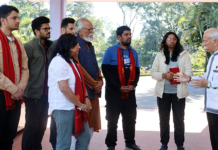[Prem Chetry]
JERIGAON, 19 Sep: The centuries-old art of making clay pots and vessels, which once dominated the socioeconomic and cultural spheres of different communities of Jerigaon village in West Kameng district, is on the verge of extinction.
Aluminium utensils came much later, and even so, big aluminium utensils were not affordable in those days.
Only a few women in Jerigaon specialised in making clay pots, vessels and containers for different purposes. 79-year-old Tabi Sunickjee is now the only woman in the village who knows the art, having learnt it from her mother, late Tongchi Doima. She is the only woman artisan with the skill to make clay articles.
“There was a time when our clay vessels, utensils and pots were in high demand from far and near. However, modernisation has replaced them,” she said.
“I want this art to be passed down to our young generation, as I inherited it from my mother. Unfortunately, our young generation does not want to take up this profession,” she added.
Meanwhile, Sange Thinchu Nathongjee, a resident of the village who has been enthusiastic in preserving this art, said: “In 1985, there were five female artisans in the village. Now we have only one. I personally implored her to teach her skills to our young women and girls. Unfortunately, no one turned up.”
“This is the legacy of our cultural heritage; it must be preserved not as a profession but as a professional. Sunickjee is the only woman left in our village; if no takes up this art, it will vanish from the region,” said Nathongjee.
Clay pots, vessels, utensils and religious vessels and pots were in high demand in those days. People from Tawang, Sangti, Dirang, Thembang, Nafra, Naku, Dibin, Khajalang and Rupa used to trade with these articles.
Sunickjee said that “in those days, people exchanged our pots and vessels with sheep, goats, food grains,and later with money.”
Making these clay articles require a fine-grained soil, which is only found in a particular community land. It takes nearly a day to bring the soil to the village. The soil is then ground, sieved and converted into clay to be moulded into desired shapes and sizes.
Once dried in the sun, the articles are then set on fire and plastered with sealing wax.





